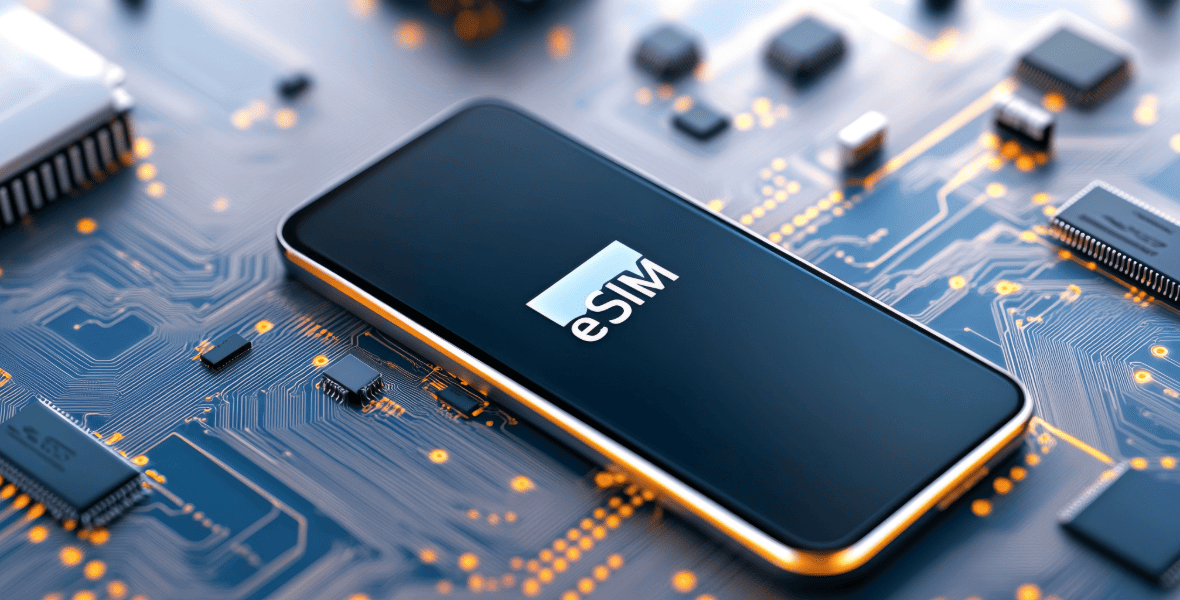Table of Contents:
- What is an eSIM card and how does eSIM work?
- What makes an eSIM different from a physical SIM card
- How does an eSIM work as a digital SIM?
- What is remote SIM provisioning, and how does it work with eSIM?
- What are eSIM profiles, and how can they store multiple SIM profiles?
- What is the eUICC?
- How can you activate an eSIM?
- What role does a QR code play in eSIM activation?
- What devices are compatible with eSIM?
- How does eSIM compatibility affect dual SIM functionality?
- What are the advantages of eSIM?
- How does eSIM benefit travelers?
- What is a travel eSIM, and how does it work?
- How can eSIM simplify switching between mobile networks while traveling?
What is an eSIM card and how does eSIM work?
An eSIM, or embedded SIM, is a digital alternative to the traditional SIM card. Unlike the physical version that requires manual insertion into your device, an eSIM is seamlessly integrated into gadgets like:
- smartphones,
- tablets,
- smartwatches,
- drones,
- cars.
This built-in technology enables devices to connect to networks via remote software updates. With an eSIM, switching devices or carriers doesn't require changing card, making it a streamlined and efficient solution for modern connectivity. For more details on transferring an eSIM between devices, you can refer to our comprehensive guide.
What makes an eSIM different from a physical SIM card?
An eSIM is embedded directly into a device, whereas a traditional SIM card requires manual insertion and replacement. With an eSIM, users can remotely program and switch carriers or service plans without needing a new SIM card, unlike physical SIMs that must be manually swapped out.
How does an eSIM work as a digital SIM?

An eSIM functions as a digital SIM, where the necessary details for mobile network access are stored as software on the device’s eUICC module rather than on a separate physical chip. This allows users to activate, modify, and switch mobile services remotely without needing a physical SIM.. With an eSIM, downloading carrier profiles and managing or switching between various service plans becomes effortless through your device settings.
What is remote SIM provisioning, and how does it work with eSIM?
Remote SIM provisioning enables users to download and manage mobile service profiles without needing a physical SIM card. This technology enables the seamless downloading of new carrier profiles directly onto a device, which is particularly beneficial when using eSIMs—chips that digitally store these profiles.
Switching carriers or altering service plans becomes a breeze since there's no need to physically replace a SIM card. This advancement offers significant convenience by enabling quick changes via your device's settings, ensuring seamless connectivity across different networks and greatly enhancing the user experience.
What are eSIM profiles, and how can they store multiple SIM profiles?
eSIM profiles represent digital versions of mobile service plans, offering a contemporary method to connect with mobile networks. Stored on an eSIM, these profiles allow users to manage multiple SIM profiles simultaneously, enabling effortless switching between carriers or plans without the hassle of physical SIM cards. With everything digital, changing network providers is as simple as adjusting device settings. This enhances flexibility and convenience when managing mobile services. The technology simplifies carrier management and plan adjustments, catering to diverse user needs without the inconvenience of dealing with physical cards.
What is the eUICC?
The eUICC (Embedded Universal Integrated Circuit Card) specification enables the eSIM module to store multiple mobile service profiles, playing a crucial role in modern connectivity. While eSIMs don't have a physical ICCID like traditional SIM cards, the eUICC itself has a unique identifier for SIM cards, known as an EID. This innovative technology allows users to remotely add and manage these profiles, making it simple to switch between different carriers or plans. With an eSIM module that complies with the eUICC specification, traditional physical SIM cards become obsolete, streamlining connectivity and offering greater convenience. Facilitating seamless transitions between networks significantly boosts flexibility in managing mobile services.
How can you activate an eSIM?

Activating an eSIM involves some simple steps, which might vary depending on your device and mobile service provider.
Typically, you will either scan a QR code from your carrier or manually enter activation details.
Here's a guide to get started:
- Verify compatibility:ensure your device supports eSIM technology.
- Obtain the QR code:your carrier will provide the necessary QR code for activation, usually via email or through their app or website.
- Initiate activation:Directly scan the QR code or access your device's settings, navigate to the cellular or network section, and choose "Add Cellular Plan." then use your camera to scan the QR code you've received.
- Complete any additional steps:Some carriers may require extra actions such as entering a confirmation code or downloading their app.
- Adjust your settings:once activated, tweak settings as needed—for instance, selecting your eSIM as the data provider while traveling and using your primary line for the calls.
- Verify connectivity:Restart your device and check its connectivity to confirm activation.
This method eliminates the hassle of physical SIM cards and offers greater flexibility in choosing and switching carriers by simply adjusting settings on compatible devices.
What role does a QR code play in eSIM activation?
QR codes are essential for activating eSIMs, streamlining the process of downloading and setting up an eSIM profile. Scanning the QR code provided by your eSIM operator prompts your device to automatically configure the necessary settings and activate the eSIM. This approach eliminates the hassle of manual input, ensuring fast and smooth connectivity.
What devices are compatible with eSIM?
A wide range of modern smartphones and gadgets, including those from Apple, Samsung, and Google, now are eSIM compatible.
- iPhones starting with the XS model support this feature, with newer models like the iPhone 15 in the USA exclusively offering eSIM by omitting the physical SIM slot (note: not all regional variants, such as some Chinese models, offer eSIM support),
- Samsung's Galaxy S20 series and later models,
- Google Pixels beginning with the Pixel 3 also have eSIM capabilities,
- Cellular-enabled tablets like iPads often come with this technology,
Some laptops are eSIM compatible too; notable examples include specific models from HP and Lenovo. However, it's crucial to review each device's specifications since not every model supports this techno. An eSIM enhances dual SIM functionality by allowing users to manage several carrier profiles without needing physical SIM cards.
How does eSIM compatibility affect dual SIM functionality?

With eSIM compatibility, using dual SIMs becomes significantly more convenient, allowing you to operate both a physical SIM and an eSIM simultaneously. This functionality provides the freedom to manage multiple phone numbers or service plans on a single device. For instance, it facilitates effortless switching between different carriers or networks whenever necessary. It's particularly advantageous for individuals requiring distinct numbers for personal and professional purposes or those frequently updating their network plans. Additionally, the dual SIM feature with eSIMs eliminates the need to carry several devices, streamlining your communication and connectivity management.
What are the advantages of eSIM?
eSIM technology revolutionizes user experience and connectivity with several noteworthy advantages.
- Convenience:Manage multiple plans without swapping physical SIMs. This feature is especially advantageous for frequent travelers or those who often switch carriers, making network transitions smooth and cutting down on roaming charges.
- Flexibility:Users have the freedom to add or change service providers directly from their device settings,
- Time-Saving:eliminating trips to stores or waiting for new SIM cards to arrive by mail.
- Environmental benefits:eSIMs contribute positively to environmental efforts by eliminating the need for manufacturing and disposing of plastic SIM cards. By minimizing plastic waste, they promote more eco-friendly technological practices.
- Better connectivity for travelers:Switch networks easily without searching for local SIM cards.
What is the environmental impact of eSIM compared to physical SIM cards?

eSIMs offer a more eco-friendly alternative to traditional SIM cards, significantly reducing their environmental footprint. Unlike physical SIMs (which are produced in billions each year and contribute to tens of thousands of tons of plastic waste) eSIMs eliminate the need for plastic cards, leading to much lower waste production. Lifecycle assessments have indicated that over the typical three-year usage of a smartphone, eSIMs can reduce CO₂ emissions by roughly 46% compared to physical SIM cards, primarily by removing the energy-intensive processes of manufacturing, packaging, and global transportation. By embracing eSIM technology, manufacturers can decrease their reliance on non-renewable resources required to produce millions of physical SIM cards annually. This transition not only fosters sustainability within the telecommunications industry but also plays a crucial role in advancing environmental responsibility while cutting down on overall resource consumption.
What are the disadvantages of eSIM?
eSIM technology offers a fresh approach to connectivity, yet it comes with its own set of challenges. One significant drawback is the inability to physically remove an eSIM.
Another hurdle is compatibility; not every device supports eSIMs. Many older models and certain brands lack this feature, which can limit a user's flexibility.
Additionally, eSIMs may encounter restrictions with specific data plans or service providers. Not all mobile operators provide comprehensive support for eSIMs, potentially complicating your choice of the ideal plan or network—especially if you frequently change carriers or seek diverse options.
In essence, while eSIMs simplify connectivity by eliminating physical cards, these limitations are crucial for potential users to consider regarding device compatibility and carrier support.
How does eSIM benefit travelers?

eSIM technology significantly enhances the travel experience by making connectivity effortless. When arriving in a new country, travelers can quickly activate international plans on their devices without hunting for physical SIM cards. This eliminates the need to track down local SIMs and grants immediate access to networks, ensuring a smoother journey.
To list some benefits:
- Instant connectivity: Activate international plans without searching for physical SIMs.
- Seamless network switching: Easily switch between carriers through device settings.
- Lower roaming costs: Avoid expensive roaming fees by selecting local plans.
What is a travel eSIM, and how does it work?
A travel eSIM is a digital SIM that allows travelers to connect to mobile networks in multiple countries without swapping physical SIM cards. Users can download an eSIM profile before departure or upon arrival, granting immediate access to local mobile networks. This simplifies international connectivity by removing the need to purchase and insert a physical SIM.
How can eSIM simplify switching between mobile networks while traveling?
eSIMs enable travelers to activate and switch between local network providers directly from their device settings. This eliminates the need to search for a local SIM card or deal with high roaming charges. With a few taps, users can instantly connect to a new network, ensuring uninterrupted service throughout their trip.
Posts you might also like




